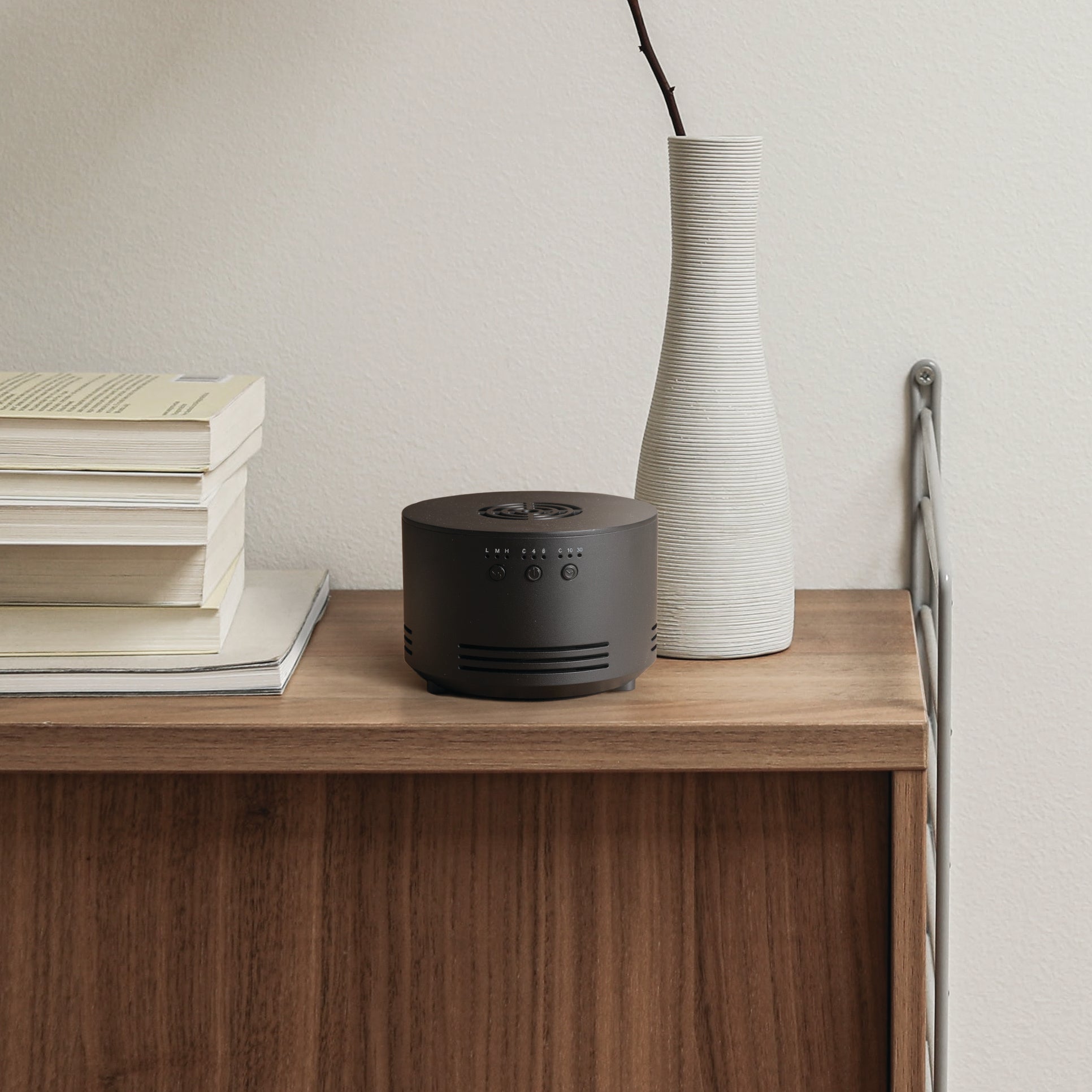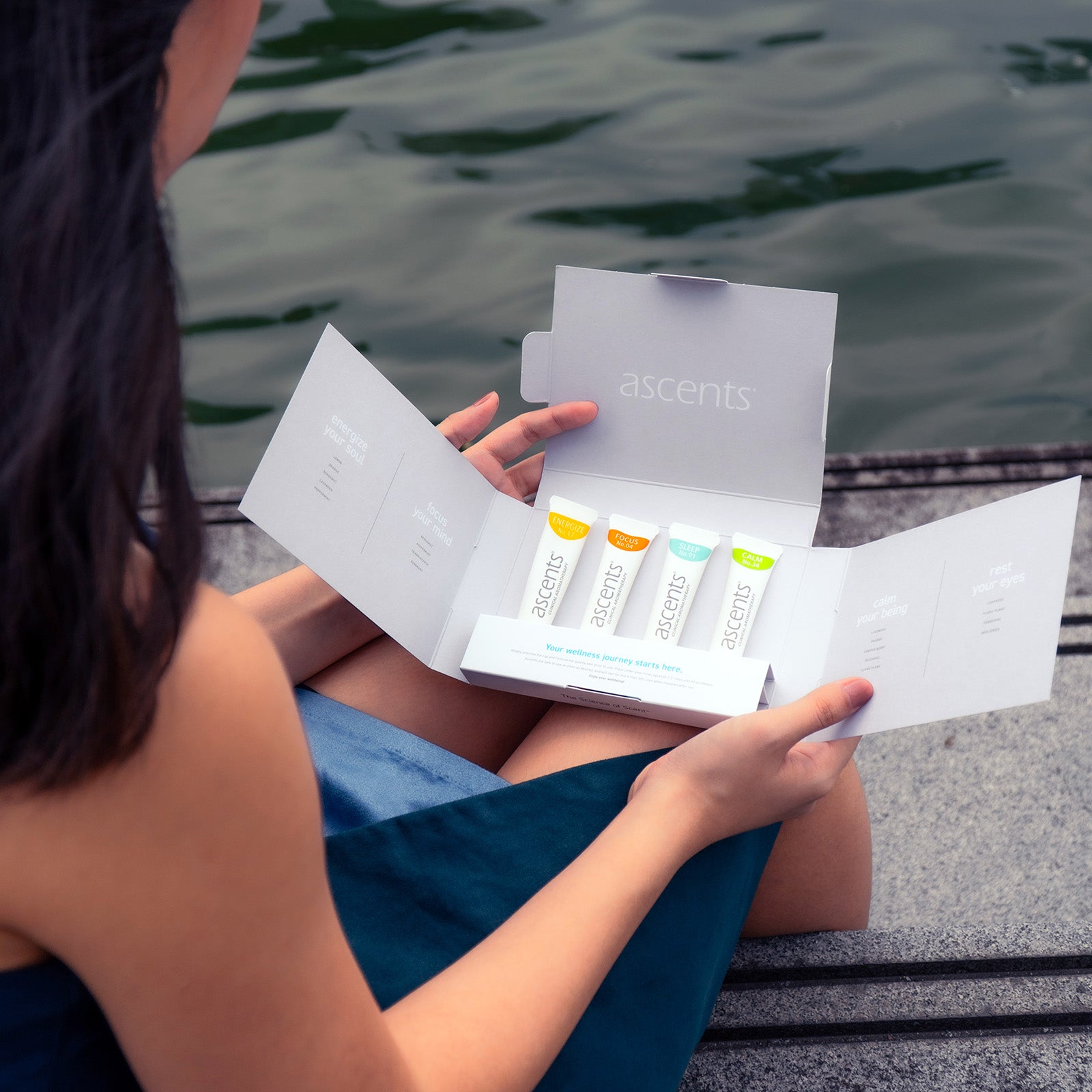Ascents® Energize No. 17: Research Abstracts for Component Oils
Effects of bergamot (Citrus bergamia (Risso) Wright & Arn.) essential oil aromatherapy on mood states, parasympathetic nervous system activity, and salivary cortisol levels in 41 healthy females.
Forsch Komplementmed. 2015;22(1):43-9. doi: 10.1159/000380989. Epub 2015 Feb 19.
Watanabe E(1), Kuchta K, Kimura M, Rauwald HW, Kamei T, Imanishi J.
Author information:
(1)Department of Immunology, Kyoto Prefectural University of Medicine, Kyoto,
Japan.
BACKGROUND: Bergamot essential oil (BEO) is commonly used against psychological stress and anxiety in aromatherapy. The primary aim of the present study was to obtain first clinical evidence for these psychological and physiological effects. A secondary aim was to achieve some fundamental understanding of the relevant pharmacological processes.
METHODS: Endocrinological, physiological, and psychological effects of BEO vapor inhalation on 41 healthy females were tested using a random crossover study design. Volunteers were exposed to 3 experimental setups (rest (R), rest + water vapor (RW), rest + water vapor + bergamot essential oil (RWB)) for 15 min each. Immediately after each setup, saliva samples were collected and the volunteers rested for 10 min. Subsequently, they completed the Profile of Mood States, State-Trait Anxiety Inventory, and Fatigue Self Check List. High-frequency (HF) heart rate values, an indicator for parasympathetic nervous system activity, were calculated from heart rate variability values measured both during the 15 min of the experiment and during the subsequent 10 min of rest. Salivary cortisol (CS) levels in the saliva samples were analyzed using ELISA.
RESULTS: CS of all 3 conditions R, RW, and RWB were found to be significantly distinct (p = 0.003). In the subsequent multiple comparison test, the CS value of RWB was significantly lower when compared to the R setup. When comparing the HF values of the RWB setup during the 10 min of rest after the experiment to those of RW, this parameter was significantly increased (p = 0.026) in the RWB setup for which scores for negative emotions and fatigue were also improved.
CONCLUSION: These results demonstrate that BEO inhaled together with water vapor exerts psychological and physiological effects in a relatively short time.
© 2015 S. Karger GmbH, Freiburg.
Does the Fragrance of Essential Oils Alleviate the Fatigue Induced by Exercise? A Biochemical Indicator Test in Rats.
Evid Based Complement Alternat Med. 2017;2017:5027372. doi: 10.1155/2017/5027372. Epub 2017 Oct 31.; Li Z1, Wu F1, Shao H2, Zhang Y1, Fan A1, Li F1.
OBJECTIVE: To study the effect of the essential oils of Citrus sinensis L., Mentha piperita L., Syzygium aromaticum L., and Rosmarinus officinalis L. on physical exhaustion in rats.
RESULTS: While an increased time to exhaustion and SOD activity were apparent in both the EOM and PEO groups, the BLA and MDA were lower in both groups, in comparison with the fatigue group, and the changes in the EOM group were more dramatic. Additionally, the EOM group also showed marked changes of the rise of blood glucose and the decrease of BUN and GSH-PX.
CONCLUSION: The results suggested that the inhalation of an essential oil mixture (Citrus sinensis L., Mentha piperita L., Syzygium aromaticum L., and Rosmarinus officinalis L. vs plain peppermint) could powerfully relieve exercise-induced fatigue.
Citrus bergamia essential oil: from basic research to clinical application.
Front Pharmacol. 2015 Mar 2;6:36. doi: 10.3389/fphar.2015.00036. eCollection
2015.
Navarra M(1), Mannucci C(2), Delbò M(3), Calapai G(2).
Author information:
(1)Department of Drug Sciences and Products for Health, University of Messina, Messina, Italy. (2)Department of Clinical and Experimental Medicine, University of Messina, Messina, Italy. (3)Italian Medicines Agency Rome, Italy.
Citrus bergamia Risso et Poiteau, also known as "Bergamot," is a plant belonging to the Rutaceae family, defined as a hybrid of bitter orange and lemon. It is an endemic plant of the Calabria region (Italy). Bergamot fruit is primarily used for the extraction of its essential oil (bergamot essential oil: BEO), employed in perfume, cosmetics, food, and confections. The aim of this review was to collect recent data from the literature on C. bergamia essential oil and, through a critical analysis, focus on safety and the beneficial effects on human health. Clinical studies on the therapeutic applications of BEO exclusively focus on the field of aromatherapy, suggesting that its use can be useful for reducing anxiety and stress.
PMCID: PMC4345801
PMID: 25784877 [PubMed]
Full PDF: http://www.ncbi.nlm.nih.gov/pmc/articles/PMC4345801/pdf/fphar-06-00036.pdf
Neuropharmacology of the essential oil of bergamot.
Fitoterapia. 2010 Sep;81(6):453-61. doi: 10.1016/j.fitote.2010.01.013. Epub 2010Jan 20.
Bagetta G(1), Morrone LA, Rombolà L, Amantea D, Russo R, Berliocchi L, Sakurada S, Sakurada T, Rotiroti D, Corasaniti MT.
Author information:
(1)Department of Pharmacobiology and University Centre for Adaptive Disorders and Headache, Section of Neuropharmacology of Normal and Pathological Neuronal Plasticity, University of Calabria, Arcavacata di Rende, CS, Italy. g_bagetta@virgilio.it
Bergamot (Citrus bergamia, Risso) is a fruit most knowledgeable for its essential oil (BEO) used in aromatherapy to minimize symptoms of stress-induced anxiety and mild mood disorders and cancer pain though the rational basis for such applications awaits to be discovered. The behavioural and EEG spectrum power effects of BEO correlate well with its exocytotic and carrier-mediated release of discrete amino acids endowed with neurotransmitter function in the mammalian hippocampus supporting the deduction that BEO is able to interfere with normal and pathological synaptic plasticity. The observed neuroprotection in the course of experimental brain ischemia and pain does support this view. In conclusion, the data yielded so far contribute to our understanding of the mode of action of this phytocomplex on nerve tissue under normal and pathological experimental conditions and provide a rational basis for the practical use of BEO in complementary medicine. The opening of a wide venue for future research and translation into clinical settings is also envisaged.
Copyright (c) 2010 Elsevier B.V. All rights reserved.
PMID: 20093169 [PubMed - indexed for MEDLINE]
Menthol enhances phasic and tonic GABAA receptor-mediated currents in midbrain periaqueductal grey neurons
Benjamin K Lau1 *, Shafinaz Karim1,2*, Ann K Goodchild2 , Christopher W Vaughan1 and Geoffrey M Drew1 1 Pain Management Research Institute, Kolling Institute of Medical Research, Northern Clinical School, The University of Sydney at Royal North Shore Hospital, St Leonards, NSW, Australia, and 2 Australian School of Advanced Medicine, Macquarie University, North Ryde, NSW, Australia
Correspondence Dr Benjamin K Lau, Pain Management Research Institute, Level 13 Kolling Building, Kolling Institute of Medical Research, The University of Sydney at Royal North Shore Hospital, St Leonards, NSW 2065, Australia. E-mail: benjamin.lau@sydney.edu.au
*These authors contributed equally to this work.
Accepted 19 January 2014
BACKGROUND AND PURPOSE Menthol, a naturally occurring compound in the essential oil of mint leaves, is used for its medicinal, sensory and fragrant properties. Menthol acts via transient receptor potential (TRPM8 and TRPA1) channels and as a positive allosteric modulator of recombinant GABAA receptors. Here, we examined the actions of menthol on GABAA receptor-mediated currents in intact midbrain slices.
EXPERIMENTAL APPROACH Whole-cell voltage-clamp recordings were made from periaqueductal grey (PAG) neurons in midbrain slices from rats to determine the effects of menthol on GABAA receptor-mediated phasic IPSCs and tonic currents.
KEY RESULTS Menthol (150–750 μM) produced a concentration-dependent prolongation of spontaneous GABAA receptor-mediated IPSCs, but not non-NMDA receptor-mediated EPSCs throughout the PAG. Menthol actions were unaffected by TRPM8 and TRPA1 antagonists, tetrodotoxin and the benzodiazepine antagonist, flumazenil. Menthol also enhanced a tonic current, which was sensitive to the GABAA receptor antagonists, picrotoxin (100 μM), bicuculline (30 μM) and Zn2+ (100 μM), but unaffected by gabazine (10 μM) and a GABAC receptor antagonist, 1,2,5,6-tetrahydropyridin-4-yl)methylphosphinic acid hydrate (TPMPA; 50 μM). In addition, menthol potentiated currents induced by the extrasynaptic GABAA receptor agonist THIP/gaboxadol (10 μM).
CONCLUSIONS AND IMPLICATIONS These results suggest that menthol positively modulates both synaptic and extrasynaptic populations of GABAA receptors in native PAG neurons. The development of agents that potentiate GABAA-mediated tonic currents and phasic IPSCs in a manner similar to menthol could provide a basis for novel GABAA-related pharmacotherapies. Abbreviations CNQX, 6-cyano-7-nitroquinoxaline-2,3-dione; THIP, 4,5,6,7-tetrahydroisoxazolo[5,4-c]pyridin-3-ol hydrochloride, gaboxadol; TPMPA, 1,2,5,6-tetrahydropyridin-4-yl)methylphosphinic acid hydrate; TTX, tetrodotoxin BJP British
Journal of Pharmacology DOI:10.1111/bph.12602 www.brjpharmacol.org
Modulation of cognitive performance and mood by aromas of peppermint and ylang-ylang.
Int J Neurosci. 2008 Jan;118(1):59-77.
Moss M(1), Hewitt S, Moss L, Wesnes K.
Author information:
(1)Human Cognitive Neuroscience Unit, Division of Psychology, University of
Northumbria, Newcastle upon Tyne, United Kingdom. mark.moss@unn.ac.uk
This study provides further evidence for the impact of the aromas of plant
essential oils on aspects of cognition and mood in healthy participants. One hundred and forty-four volunteers were randomly assigned to conditions of ylang-ylang aroma, peppermint aroma, or no aroma control. Cognitive performance was assessed using the Cognitive Drug Research computerized assessment battery, with mood scales completed before and after cognitive testing. The analysis of the data revealed significant differences between conditions on a number of the factors underpinning the tests that constitute the battery. Peppermint was found to enhance memory whereas ylang-ylang impaired it, and lengthened processing speed. In terms of subjective mood peppermint increased alertness and ylang-ylang decreased it, but significantly increased calmness. These results provide support for the contention that the aromas of essential oils can produce significant and idiosyncratic effects on both subjective and objective assessments of aspects of human behavior. They are discussed with reference to possible pharmacological and psychological modes of influence.
PMID: 18041606 [PubMed - indexed for MEDLINE]
Aroma oil therapy in palliative care: a pilot study with physiological parameters in conscious as well as unconscious patients.
J Cancer Res Clin Oncol. 2017 Oct;143(10):2123-2129. doi: 10.1007/s00432-017-2460-0. Epub 2017 Jun 20.; Goepfert M1, Liebl P2, Herth N1, Ciarlo G1, Buentzel J3, Huebner J4.
RESULTS: Healthy test persons reacted to lemon oil with a significant increase in respiration rate, heart rate and diastolic blood pressure, whereas to lavender oil with a significant decrease in respiration rate was measured. Conscious and unconscious patients reacted with a significant increase in all measured parameters to lemon oil and with a significant decrease in all parameters except for oxygen saturation to lavender oil. No significant differences in the reactions were measured between the conscious and unconscious patients and no significant reactions to control stimuli were detected. All physiological reactions were very short and only detectable during stimulus presentation.
CONCLUSION: Significant physiological reactions were measured after stimulation with aroma oils in all three groups in this study. Healthy probands showed different reactions than palliative patients irrespective to their conscious state.
Contribution of anterior cingulate cortex and descending pain inhibitory system to analgesic effect of lemon odor in mice.
Mol Pain. 2014 Feb 20;10:14. doi: 10.1186/1744-8069-10-14.
Ikeda H(1), Takasu S, Murase K.
Author information:
(1)Department of Human and Artificial Intelligence Systems, Graduate School of Engineering, and Research and Education Program for Life Science, University of Fukui, 3-9-1 Bunkyo, 910-8507 Fukui, Japan. ikeda@u-fukui.ac.jp.
BACKGROUND: Affections are thought to regulate pain perception through the descending pain inhibitory system in the central nervous system. In this study, we examined in mice the affective change by inhalation of the lemon oil, which is well used for aromatherapy, and the effect of lemon odor on pain sensation. We also examined the anterior cingulate cortex (ACC) and descending pain inhibitory system to such regulation of pain.
RESULTS: In the elevated plus maze, the time spent in the open arms was increased by inhalation of lemon oil. The pain behavior induced by injection of formalin into the hind paw was decreased. By inhalation of lemon oil, the number of c-Fos expression by formalin injection was significantly increased in the ACC, periaqueductal grey (PAG), nucleu raphe magnus (NRM) and locus ceruleus, and decreased in the spinal dorsal horn (SDH). The destruction of the ACC with ibotenic acid led to prevent the decrease of formalin-evoked nocifensive behavior in mice exposed to lemon oil. In these mice, the change of formalin-induced c-Fos expression in the ACC, lateral PAG, NRM and SDH by lemon odor was also prevented. Antagonize of dopamine D1 receptor in the ACC prevented to the analgesic effect of lemon oil.
CONCLUSIONS: These results suggest that the analgesic effect of lemon oil is induced by dopamine-related activation of ACC and the descending pain inhibitory system.
PMCID: PMC3936890
PMID: 24555533 [PubMed - indexed for MEDLINE]
The sleep-enhancing effect of valerian inhalation and sleep-shortening effect of lemon inhalation.
Chem Senses. 2006 Oct;31(8):731-7. Epub 2006 Jul 20.
Komori T(1), Matsumoto T, Motomura E, Shiroyama T.
Author information:
(1)Department of Psychiatry, Division of Neuroscience, Institute of Medical Science, Mie University Graduate School of Medicine, Tsu, Mie 514-8507, Japan.
t-komori@clin.medic.mie-u.ac.jp
We examined the effects of odorant inhalation on the sleep-wake states in rats. Odorants used in the experiment were clove, jasmine, lavender, lemon, peppermint, pine, rose, sandalwood, valerian, and ylang-ylang. Valerian and rose inhalation significantly prolonged the pentobarbital-induced sleeping time, whereas lemon inhalation significantly shortened it. The effect of valerian inhalation was markedly noticeable. In the anosmic rats, a significant effect of odorants on the pentobarbital sleep time was not seen. Electroencephalographic studies on natural sleep revealed that rose inhalation did not exert any significant effect on sleep, but a significant shortening in sleep latency and a significant prolonging in total sleep time were observed with valerian inhalation, whereas a significant prolonging in sleep latency was observed with lemon inhalation. Such effects of valerian and lemon inhalation were not admitted in anosmic rats. Gamma-Aminobutyric acid (GABA) transaminase assay indicates that valerian inhalation decreases the activity of the enzyme and enhances GABA activity. Although valerian has been reported to exert a good effect for sleep as a medicine for internal use, the present study is the first medical report suggesting that the inhalation of valerian may enhance the sleep. On the other hand, the present results may suggest the possibility that lemon inhalation may cause a worsening of insomnia symptoms.
PMID: 16857858 [PubMed - indexed for MEDLINE]
Ambient odors of orange and lavender reduce anxiety and improve mood in a dental office.
Physiol Behav. 2005 Sep 15;86(1-2):92-5.
Lehrner J(1), Marwinski G, Lehr S, Johren P, Deecke L.
Author information:
(1)University Clinic of Neurology, Medical University of Vienna, Austria.
johann.lehrner@meduniwien.ac.at
The goal of this study was to investigate the impact of the essential oils of orange and lavender on anxiety, mood, alertness and calmness in dental patients. Two hundred patients between the ages of 18 and 77 years (half women, half men) were assigned to one of four independent groups. While waiting for dental procedures patients were either stimulated with ambient odor of orange or ambient odor of lavender. These conditions were compared to a music condition and a control condition (no odor, no music). Anxiety, mood, alertness and calmness were assessed while patients waited for dental treatment. Statistical analyses revealed that compared to control condition both ambient odors of orange and lavender reduced anxiety and improved mood in patients waiting for dental treatment.
These findings support the previous opinion that odors are capable of altering emotional states and may indicate that the use of odors is helpful in reducing anxiety in dental patients.
PMID: 16095639 [PubMed - indexed for MEDLINE]
Effects of olfactory stimulation with rose and orange oil on prefrontal cortex activity.
Complement Ther Med. 2014 Dec;22(6):1027-31. doi: 10.1016/j.ctim.2014.09.003.
Epub 2014 Sep 28.
Igarashi M(1), Ikei H(1), Song C(1), Miyazaki Y(2).
Author information:
(1)Center for Environment, Health and Field Sciences, Chiba University, Kashiwanoha 6-2 1, Kashiwa, Chiba 277-0882, Japan. (2)Center for Environment, Health and Field Sciences, Chiba University, Kashiwanoha 6-2-1, Kashiwa, Chiba 277-0882, Japan. Electronic address: ymiyazaki@faculty.chiba-u.jp.
OBJECTIVES: People have been aware of essential oils, which are derived from plants, for a long time. Recently, we have become interested in physiological and subjective effects of daily exposure to essential oils. The primary aim of the present study was to clarify effects of olfactory stimulation with rose or orange oil on prefrontal cortex activity; subjective evaluations of relaxation were also determined.
SETTING AND INTERVENTIONS: Subjects were exposed for 90s to air impregnated with either rose or orange essential oil. As a control, subjects wore the same device but inhaled only unimpregnated air. The three stimuli were randomly presented to each subject.
MAIN OUTCOME MEASURES: Physiological effects were determined by near-infrared time-resolved spectroscopy and a modified semantic differential approach was used to determine subjective evaluations.
RESULTS: The study participants were 20 female university students (mean age 22.5±1.6 years). Olfactory stimulation by rose or orange oil induced: (1) a significant decrease in oxyhemoglobin concentration in the right prefrontal cortex and (2) an increase in "comfortable," "relaxed," and "natural" feelings.
CONCLUSION: These findings indicate that olfactory stimulation by rose or orange oil induces physiological and psychological relaxation.
Copyright © 2014 Elsevier Ltd. All rights reserved.
PMID: 25453523 [PubMed - indexed for MEDLINE]





